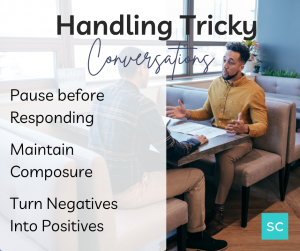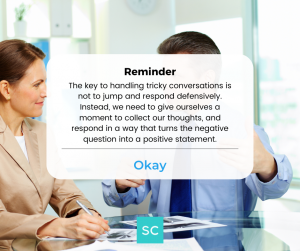Handling Tricky Conversations
Tricky or difficult conversations can be tough to navigate. When these situations occur, our hearts tend to beat quickly, and we might start to sweat. These reactions are entirely normal.
According to a recent survey, 37% of managers said they’re uncomfortable giving direct feedback to their employees.
Tricky conversations are part of the workplace, but this doesn’t mean we can’t get better at them. Below are three strategies to help turn negative conversations into positive ones.
1. Down-Up-Point Movement
When we are put on the spot or asked a difficult question, our first reaction may be to say uh, or um. However, instead of this, we can take a moment to pause and implement the down-up-point movement.
Consider the following:
- Pause – The first thing we can do is pause before we jump to respond. When we do this, we stop ourselves from stammering or saying something we didn’t intend to say. Pausing before we speak will give us a moment to collect our thoughts.
- Look Down And Nod – As we pause, we can look down and nod our heads. This will make it appear like we are thinking about our answer. It will give us a moment to think about what we would like to say.
- Respond – After we have taken a moment to pause and look down, we can look up and be pointed in our response.
The key in the down-up-point movement is to be mindful to catch ourselves before responding defensively.
2. Responding
If we are asked a question that touches a nerve, we need to be careful about how we respond. There are several ways we can respond with composure.
Consider the following:
- Transition Words – Transition words can help us if we are caught off guard by a question, or don’t want to jump to respond. For example, we can start our response with, “What I can say is,” or “As a matter of fact,” or “In fact.” Then, we can bring up something positive about this point. We want to end with something positive, even if the question asks about a weakness.

- Stick To Our Message – If we are continually asked the same question, we must ensure we are sticking to our message. For example, we can say something like, “As I said before,” or “Like I said.” When we do this, we can maintain our composure, even if the other person is trying to get us to feel flustered.
- Keep It Short – There will also be a time when we don’t know the answer. This could be because we don’t have or know the current information. The best thing we can do when this happens is to keep our answers short.
As we respond, we want to stay positive and maintain our composure.
3. Maintain Control
Most of the time, we won’t have the chance to prepare ourselves for tricky conversations; they usually come out of the blue. However, there are several strategies we can use to help us maintain control over the situation.
Consider the following:
- Restate – Often, when we are asked a tricky question, we may be quick to respond with the first thing that comes to our minds. When we restate what the person said or asked, it gives us time to clarify their ask and allows us to consider how exactly we want to respond. For example, we can say, “What I think you are asking me is, XYZ, is this correct?” Or we can say, “Did you ask if I can do XYZ?” Restating will help us formulate our response positively.

- Redirect – When we are asked a tricky question, we need to remember, we are in control. We have the power to determine the direction of the conversation. We can do this by redirecting the conversation. For example, we respond with a question, or we can move on from the question. The key is to keep our redirection positive and not get defensive with our response.
- Reframe – Reframing means taking what someone has asked us, using the question’s theme, and drawing attention to another point in the same theme. When we do this, it doesn’t seem like we may be dodging a question because we are still speaking to the general theme of what they asked. For example, if someone asks us about an investigation, we can answer about the investigation, but only the parts we feel comfortable speaking to.
Restating, redirecting, and reframing can help us maintain control when handling tricky conversations.
The key to handling tricky conversations is not to jump and respond defensively. Instead, we need to give ourselves a moment to collect our thoughts, and respond in a way that turns the negative question into a positive statement.
___
Whenever you’re ready, there are 3 ways we can help you:
- Discover your communications style, so you know where to start. Over 4,000 people have found theirs here.
- Attend our monthly communication workshop to build communications confidence (new topics: public speaking, advocating for yourself, building credibility, etc) here.
- Get your brand in front of 43k+ people by sponsoring our newsletter or Soulcast Media | LIVE LinkedIn events [contact: hello@soulcastmedia.com]











